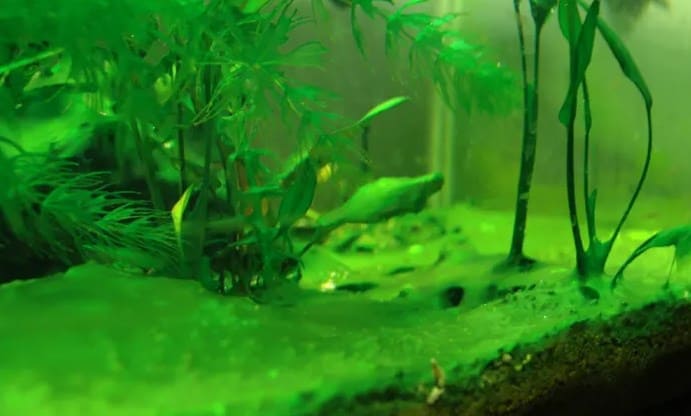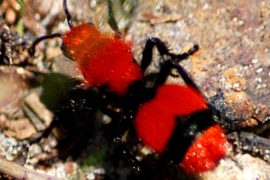Blue-green algae are also known as slime algae due to their consistency. They used to be counted among the algae and are still often referred to as such today. In the biological sense, however, it is not a type of algae: blue-green algae are cyanobacteria. However, they have one thing in common with algae: in the aquarium, they are formed as a result of an imbalance in the water chemistry. Blue-green algae or slime algae are usually colored green-grey to brown-blue. They are easily recognized by their characteristic appearance.
Which aquarium plants are attacked by blue-green algae?
Blue-green algae attack all kinds of aquarium plants. They particularly like to perch on the leaves. A coating of slimy algae prevents plants from photosynthesizing and thus from nutrient uptake. If a plant in the aquarium is completely covered by them, it will soon wither – unless you help the plant quickly. Fortunately, the blue or slime algae are usually easy to eliminate.
Help plants affected by blue-green algae quickly – otherwise the bacteria will continue to thrive and the causes of the algae infestation will be further aggravated.
How are blue-green algae formed in the aquarium?
Just like aquarium plants and algae, which belong to the lower plants, blue-green algae need one thing above all to grow: light. Just like plants, they make their food by using photosynthesis, i.e. converting light energy into food.
Algae already have the advantage over aquarium plants that they make fewer demands on their environment and still thrive whereas aquatic plants are already reacting with reduced growth. Cyanobacteria (or blue-green algae or slime algae) are an even stronger competitor: while plants can only use a part of the light spectrum for photosynthesis, blue-green algae are able to utilize the light spectrum almost completely.
A problem for aquarium owners is that blue-green algae not only compete with the aquarium plants and prevent them from photosynthesizing, which further exacerbates the problem: the inhabitants of the aquarium can also be endangered by cyanobacteria. They often release toxins, i.e. poisonous substances.
Facts about cyanobacteria
- Some cyanobacteria do not produce oxygen during photosynthesis.
- Many species engage in nitrogen oxidation: nitrogen (N2) is converted into ammonium (NH4 +).
- Cyanobacteria produce very different toxins.
Caution: Blue-green or slime algae are not only a threat to aquarium plants, but also to animals and invertebrates that are kept in the aquarium.
Identify blue-green algae in the aquarium
Thanks to their typical properties, blue-green algae are usually easy to identify.
Odor. Do you notice an unpleasant, putrid, musty smell when you open the aquarium?
Looks. Can you see greasy deposits that are not rich green but rather dark green or bluish?
texture
Do decorative items covered by the algae feel greasy or slippery?
Based on these characteristics, blue-green algae can be easily distinguished from other, real types of algae such as green algae.
Eliminating the cause and combating it
There can be reasons for an infestation with cyanobacteria
- Water changes done too infrequently or too little
- Inadequate maintenance of the aquarium
- Too many fish and/or invertebrates
- Feeding too much and/or too often
- Lighting too intense or too long
- Filter performance too high (phosphate values increase sharply)
First step: If you discover blue-green algae in your aquarium, immediately check all the important factors. You can also find more tips in our article on algae in the aquarium.
Second step: An increased phosphate value should be reduced immediately by throttling the filter system. If this is done, you have already laid the foundation for the removal of the blue-green algae.
Third step: Remove the existing blue-green algae from the aquarium as thoroughly as possible – by skimming them off, sucking them off with a hose, or cleaning the infested surfaces.
A dark cure against blue-green algae infestation
Have you carried out all the measures but still not been able to get rid of the blue-green algae?
Then try a so-called dark cure.
To do this, proceed as follows:
- Water change of at least 80 percent of the pool contents
- Additional aeration of the aquarium using a membrane pump
- throttling of filter performance
- Setting the CO2 fertilization, if available
Once these preparations have been made, cover the aquarium completely so that no more light can get in – for example with a blanket or with cardboard on the aquarium panes. Do not feed your fish or feed them as little as possible during the dark cure. After three days of dark cure, change the water (up to 50 percent), after seven days you can illuminate the pool again. Perform a water change of up to 90 percent again.
If the dark cure was successful, the cynobacteria, blue-green algae, or slime algae in your aquarium should now be eliminated. The advantage of this method is: It does not require any chemical algaecides. In principle, these should only be used if the causes of an algae infestation have been identified and eliminated.
We are happy if we could help you with our information and tips on blue-green algae and how to combat them. What is your experience with cyanobacteria? We look forward to your comments!





